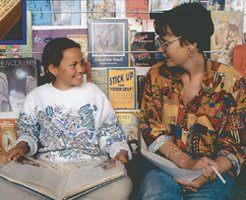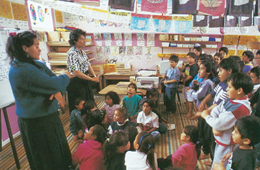![]() MÄORI
STUDENT ACHIEVEMENT IN NEMP, 1995–2000
MÄORI
STUDENT ACHIEVEMENT IN NEMP, 1995–2000
![]()
Terry Crooks, Katherine
Hamilton and Robyn Caygill
Many
research reports and commentaries on education in New Zealand
have claimed that Mäori students are performing distinctly
less well than their non-Mäori classmates. Much of the evidence
has been derived from multiple-choice tests in a narrow range
of subjects, or from performance in examinations in the final
years of secondary school. In this study, results for NEMP assessments
of Mäori and non-Mäori students in Year 4 and Year 8
were compared. |
| The study focused on about 600 tasks, covering 15 different curriculum areas, administered to individual students between 1995 and 2000. For each task, an effect size was calculated by subtracting the mean score obtained by non-Mäori students from the mean score obtained by Mäori students and dividing the difference by the pooled standard deviation for the two groups of students. These effect sizes were then averaged for each subject and each year level. |
The average effect sizes were then converted to percentile ranks to
describe how the average Mäori student performed relative to
the full range of non-Mäori students. To examine the confounding
effect of socioeconomic factors, the analyses were repeated using
only data from students attending medium- decile schools. |
•
For the Year 4 students, average Mäori performance was above
the 50th percentile of non-Mäori students for one subject,
between the 40th and 46th percentiles for six subjects, and between
the 29th and 39th percentiles for eight subjects. Averaged across
all subjects, an average Mäori student was performing as well
or better than 40 percent of non-Mäori students. In regard
to students in medium-decile schools, the average across all subjects
rose to the 43rd percentile. |
|
|
•
At Year 8, average Mäori performance was above the 50th percentile
of non-Mäori students for one subject, between the 40th and
43rd percentiles for five subjects, and between the 31st and 39th
percentiles for nine subjects. The average across all subjects was
the 40th percentile. For students in medium-decile schools, the
average across all subjects rose to the 42nd percentile. |
• Mäori boys performed a little better than Mäori girls on social studies, physical education and science tasks, and at Year 4 level on mathematics tasks. They performed quite badly relative to girls on writing. Other subjects generally showed no difference or a modest advantage for girls. The gender patterns for the Mäori students and the total sample were very similar. |
![]()
• While the overall picture shows Mäori students performing less well than their non-Mäori counterparts in most curriculum areas, the disparities varied considerably across the 15 curriculum areas assessed. Mäori students performed better than non-Mäori students in physical education, but substantially worse in reading, information skills and mathematics. The other 11 subjects fell in between. •
Comparisons of Mäori and non-Mäori student achievement
can be misleading because the majority of Mäori students
attend lower decile schools than is typical for other students.
When the comparisons are conducted on a more ‘level playing
field’ (medium-decile schools), achievement disparities
decrease markedly. |
• Numerous explanations have been suggested for the lower performance of Mäori students. There is a need to reassess these explanations to take into account the more varied patterns of achievement reported here and the confounding of ethnic and socioeconomic factors in most previous studies of Mäori students’ achievement.
|

